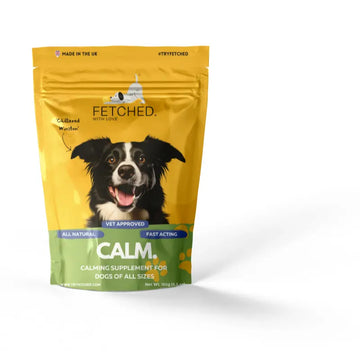Here are 105 interesting, pawsome and amazing dog facts!
Some of these are just interesting facts, while others can be helpful in training your new puppy or fully grown dog, and will help you better understand them.
I have also included some practical tips in here as well. For example, knowing that a dog sneezing when he plays with you is likely their way of saying "I'm just playing, and I don't intend to hurt you.”. Such tips may help you better interact with them.
1. A dog's sense of smell is thought to be up to 100,000 times more sensitive than humans.
A dog's nose dominates its brain; there is even an olfactory part of the brain, just like us humans do. The difference is that this part can dominate their brain and therefore makes them excellent trackers and detectors of substances.
This is why they are often used in the police force to detect drugs or lately in healthcare to detect a range of diseases, including Covid 19! (Source)
2. Dogs belong to the Canidae family
The Canidae family also includes other animals such as wolves, foxes and jackals. While the others are not easily domesticated, it’s fascinating how the domestic dog has managed to stand out and become a beloved pet by so many people!
3. The domestic dog (Canis lupus familiaris) is a direct descendant of the gray wolf
Genetic research has discovered that the domestic dog originated from grey wolves, who would count as its ancestor. According to DNA studies, this first evolution is likely to have first started about 130,000 years ago. (Source)

4. Dogs have been bred by humans for thousands of years, possibly up to 30,000 years.
Evidence suggests that the domestication of dogs began between 20,000 and 40,000 years ago in the Early Neolithic period. This means our bond with dogs predates the advent of agriculture and is among the oldest known relationships between humans and another species. (Source)
5. There are over 340 different dog breeds worldwide
While the AKC (American Kennel Club) only recognises 190 breeds, the FCI (Federation Cynologique Internationale) recognises over 340. However, the true number is likely to be even higher as there are breeds that are not even recognised by an organisation yet as they may be limited in number or as yet unidentified.
This high number reflects the variety of roles dogs play in human societies, from herding livestock and hunting game to providing companionship. They each have their own personality and their unique characteristics and temperaments tailored to the specific tasks they are best at. (Source)
6. Dogs have a sense of time and can predict future events such as regular walk times
Your pet likely knows when it's time for dinner, a walk or the time for you to come back from work! You may have seen those videos waiting for the school bus to get back at the same time every day. They use their internal clock to predict regular events in their day. There is also evidence that they perceive time to pass slower than us humans do! (Source)
7. The Basenji dog breed is known as the "barkless dog"
While most dogs communicate using a range of barks, the Basenji, native to central Africa, doesn't bark in the typical way. Instead, it produces unique vocalization sounds known as yodels or “baroos,”.
This is a fascinating insight into the different ways of communication available to animals.
8. Dogs may be able to process faces due to a specialised area in their brain dedicated to facial recognition, much like humans.
Recent research from 2015 has found that dogs, like humans, have a specialized brain region for recognizing faces. This could explain why dogs are so attuned to human emotions and adept at social interaction. (Source)
9. Dogs' whiskers help them to sense tiny changes in airflow.
Just like in cats, a dog's whiskers, or vibrissae, are sensitive to minute changes in air currents and pressures. This amazing feature helps dogs navigate the world, particularly in the dark, and sense approaching dangers.
10. A Greyhound could beat a Cheetah in a long-distance race
While a cheetah is astonishingly fast in a short sprint, it can't maintain its speed for long due to a relative lack of stamina. Greyhounds, on the other hand, have excellent stamina and can keep running at a high speed for a much longer distance. (Source)
11. Dogs curl up in a ball when sleeping to protect their vital organs
This is a behavior inherited from their wild ancestors, who had to sleep in the wilderness and defend themselves even when resting. It's a survival mechanism, protecting the most vulnerable parts of their body, in their abdomen.
Despite the safety of a modern home, in cases where a dog does not feel fully safe with their surroundings, or if they are anxious, they will still retain this behavior.

12. The Dalmatians, famous for their spotted coat, are actually born white.
Dalmatian puppies are born with a pure white coat. Their black spots only start to appear as they grow older. This change is due to a gene which delays the development of their spots until after birth.
13. Puppies have 28 teeth, while adult dogs have 42 (and humans have 32).
Puppy teeth, also known as "milk teeth," start to come in when they are about 4 weeks old. As dogs grow, these baby teeth fall out, and by the time they reach six months, most dogs have their full set of 42 adult teeth.
This process is similar in humans where children will lose their baby teeth so they can grow permanent ones.
14. The French Bulldog is the most popular breed in the US, outranking the Labrador Retriever that has been the most popular dog breed in the U.S. for many years.
According to the American Kennel Club, for the first time in over 30 years, the Labrador Retriever has been outranked as the the most registered dog breed in the U.S. (Source)
15. Dogs are capable of “hearing” your human emotions.
Dogs are very attuned to human emotions and can often sense when their owners are feeling sad, anxious, or happy. Some research suggests that they can read our facial expressions and body language, showing how closely intertwined our lives with dogs have become. (Source)
16. Stray dogs in Russia have learned to use the subway.
Interestingly, a recent report showed that about 20 stray dogs in Moscow, have learnt to use the subway to get around the city. They use it to travel to more populated areas in search of food, showing remarkable problem-solving abilities. (Source)
17. The Saluki is one of the oldest known breeds of domesticated dog.
With a history that traces back to 329 BC, the Saluki was regarded as royal dogs by the ancient Egyptians. They are fast, agile hunters and have been used for hunting gazelles, rabbits, and other game. (Source)

18. Puppies sleep a lot because their bodies release a growth hormone only when they're asleep.
Just like in humans, sleep is vital to a dog’s growth and has also been involved in memory consolidation. For puppies, sleep time is also when growth hormone is released.
This is why puppies often sleep for up to 20 hours a day, to support their rapid physical growth and learning. On average, most dogs sleep for about 12-14 hours per 24-hour period but puppies as well as older dogs can sleep more. (Source)
19. Small dog breeds often live longer than larger breeds.
Size and lifespan in dogs are inversely correlated. Smaller breeds tend to outlive larger ones. The reason for this is not fully understood but it may have to do with the overall strain on larger dogs' bodies. (Source)
20. The Norwegian Lundehund breed has six toes on each foot.
In contrast to the majority of dogs who only have five toes (just like humans) on each foot, the Norwegian Lundehund has six! It has developed this adaptation for better grip on steep and uneven Scandinavian terrains to help it hunt food and survive.
21. Dogs can get sunburned, especially those with short, fine or light-colored coats.
Just like humans, dogs can suffer from sunburns too. Those with short or light-colored coats are more susceptible to sun damage. They can also overheat so it’s essential to provide shade when they're outside. You can also apply sun screen for dogs in any skin exposed areas. (Source)
22. Newfoundlands have water-resistant coats and webbed feet.
Originally bred to help fishermen in Canada, the Newfoundland breed is one of the best breeds at swimming.
With its water-resistant double coat and webbed feet it has developed a natural adaptation that allows it to work as a water rescue dog and perform other aquatic tasks exceptionally well.
Other dogs with webbed feet include the Portuguese Water Dog, the German Wirehaired Pointer, the Redbone Coonhound and even the Dachshund to a lesser extent.

23. Dogs' paws can sweat.
Dogs regulate their body temperature differently than humans. Some dogs cool down by panting, and others also sweat through the pads of their feet. This is part of why your dog may leave wet footprints on a hot day.
You may have also noticed that dogs prefer to sleep on their back, with paws in the air on a hot day. This is so the air and wind can help cool their paws down.
24. The Chow Chow and the Shar Pei are the only two dog breeds that have fully black tongues.
Most dogs have a pink tongue, but Chow Chows and Shar Peis are unique with their fully black tongues. The cause of this distinct characteristic is a high concentration of pigmented cell present in the tongue.

25. The name Shih Tzu translates to "little lion."
The Shih Tzu breed has a royal history, associated with Chinese royalty. The name translates to "little lion,”. This is more of a homage to their lion-like appearance and not their temperament. They are known to be very friendly, outgoing, and affectionate.
26. Dogs' eyes contain a special membrane called “tapetum lucidum” and this allows them to see in the dark.
The tapetum lucidum is a layer of cells in dogs' eyes that acts like a mirror, reflecting light back through the retina.
This process enhances their night vision. Cats also have this same membrane and it’s also why both dogs and cats eyes glow in the dark when exposed to light.
27. "Fido" is Latin for fidelity.
The name comes from Latin, which means faithful or loyal. The name's popularity soared when Abraham Lincoln named his dog Fido.
28. Chihuahuas have the largest brain in relation to their body size among dog breeds.
Although the Chihuahua breed is one of the tiniest, they surprisingly have a large brain compared to their overall body size. Despite this, intelligence varies greatly within and among breeds, and size isn't always indicative of a dog's learning and problem-solving abilities.
29. Dogs have been found to lower blood pressure and cholesterol levels in their owners.
Owning a dog can have positive effects on human mental and physical health. Research shows that having a dog can actually help your heart. A study done at Harvard showed that dog owners had a lower blood pressure and cholesterol levels. It can also reduce stress, and boost overall heart health, thanks to increased physical activity and companionship.
With all these heart benefits, and especially that of companionship, owning a dog may even contribute to increasing your longevity; could this be a new anti aging trick? (Source)
30. Dogs have three eyelids.
Dogs actually have a third eyelid called the 'haw' or the nictitating membrane, in addition to their upper and lower ones. The role of this additional eyelid is to provide extra protection for the eye and to help keep it moist.
31. The Bloodhound’s sense of smell is so accurate that it can be used as evidence in a court of law.
The Bloodhound's scenting ability is extremely accurate. The nose is lined with up to 230 million scent receptors (depending on breed), which is 40 times more than the human nose.
The Blood Hound’s sense of smell even features in the Guiness Book of Records and is the first animal whose tracking results and smell was deemed admissible in court.
They're often used in search and rescue or tracking because they can follow scent trails that are even days old. (Source)

32. Dogs' tails communicate their emotional state.
Do you see your tog wagging his tail often? A dog’s tail wagging is a key form of communication, with different positions and movements representing different emotions. These can range from happiness and excitement to nervousness, fear, or aggression.
For example, a relaxed dog generally holds its tail in a neutral or low position, while an anxious or submissive dog tucks its tail between its rear legs.
This is also the stance my Labrador takes when he is caught in the act of stealing food off the table!
33. The Tibetan Mastiff is one of the most expensive and large dog breeds in the world.
Originating from Tibet, Tibetan Mastiffs are known for their massive size and were traditionally used to protect livestock from predators.
They've gained a reputation as a status symbol, with some puppies reportedly sold for millions of dollars.

34. There are six types of Dachshund.
Dachshunds come in two sizes – standard and miniature – and three types of coat: smooth, long-haired, and wire-haired. This makes for a total of six different types.
They also have webbed feet which makes them better at catching prey than other dogs. All six different types have unique physical traits but share a common playful and lively temperament.
35. Dogs have a 'vomeronasal organ' to detect pheromones.
Similar to cats, some other mammals and reptiles, the vomeronasal organ (also known as Jacobson's organ) is located in the roof of the mouth. This allows dogs to 'taste' certain scents and pheromones, giving them a deeper sense of their environment and helping them interact with other dogs. (Source)
36. Poodles' haircuts initially had a practical purpose.
The Poodle was first a water dog. The elaborate clips seen on Poodles today were originally designed to help Poodles swim more efficiently. The fur was left long to protect vital organs and joints from the cold, and the rest of the body was shaved to prevent the dogs from sinking. (Source)
37. The Border Collie is considered the most intelligent dog breed.
Border Collies are frequently rated as the most intelligent dog breed. They were initially bred for herding sheep, which requires quick thinking and an ability to follow complex commands. They are now also known for their superior problem solving capabilities. (Source)
38. Dogs have more muscles in their ears than us.
Dogs have 18 muscles in each ear giving them a remarkable ability to tilt, turn, raise, and lower their ears as they wish. This not only helps them identify the source of a sound but also aids in their communication. (Source)
39. The Beagle breed has one of the best senses of smell among dogs.
Beagles have an extraordinary sense of smell, with up to 225 million scent receptors – far more than most breeds. This, together with their tracking instinct and high energy, makes them exceptional detection dogs.
For this reason they are often used in the police force for tracking and detection of illegal substances. They were also found to detect lung cancer with up to 97% accuracy! (Source)
40. The oldest dog on record is 31 years old and still going!
The oldest dog known to history, is called Bobbi and lives in Portugal He is a Rafeiro do Alentejo breed. While not all dogs can reach this age, a balanced diet, regular exercise, and routine vet care can certainly help.
Or maybe it’s just the good genes! Breeds like the Shih Tzu, Toy Poodle, and Lhasa Apso are known for typically living into their mid to late teens. I think we have a lot to learn from these age defying animals that may even help us extend our own human longevity in the near future. (Source)

41. The Doberman was created to protect a tax collector called Dobermann
The Doberman breed is relatively new, having been created in the 19th century by Karl Friedrich Louis Dobermann. He was a german dog catcher (catching stray dogs for a living) and also a tax collector. Being a tax collector in those days (and arguably also now) was a dangerous job so one day he decided to breed the ultimate protection dog.
Having had access to many different dogs from being a dog catcher, some say he most likely crossed a pinscher with a sheepdog to create what's known today as the Doberman.
Also great for hunting, the Doberman has now become known as one of the best dogs for personal protection.
42. The Australian Shepherd breed was actually developed in the United States.
Despite the name, Australian Shepherds were bred in the California, United States by ranchers who used them for herding livestock. The breed likely got its name from the Australian sheep that they were originally bred to herd.
This breed is also not for the sedentary type as its high stamina and energy means they will find it very hard to resist their impulse of running and chasing after anything that moves. (Source)
43. The St. Bernard is the heaviest dog breed.
While there are taller breeds, when it comes to weight, the St. Bernard tops the list and holds the world record for the heaviest dog ever.
These dogs, famous for their past as Alpine rescue dogs, can weigh up to 367 pounds (167 kilograms). This record was achieved by Benedictine who was the heaviest dog of all times! (Source)
44. The fastest dog breed is the Greyhound.
Greyhounds can reach impressive speeds up to 45 miles per hour (72 kilometers per hour). Their slender bodies and strong muscles make them perfectly built for fast, sustained running. For this reason they are excellent racing dogs and Greyhound races are one of the most popular spectator sports in the UK.
45. The English word "dog" has been used since at least the 14th century.
The term "dog" replaced the Old English "hound", which was common until the 15th century. The origins of the word "dog" are obscure and it is one of etymology's great unsolved mysteries. (Source)
46. Corgis were believed to be ridden by fairy warriors in ancient folklore.
According to Welsh folklore, Pembroke Welsh Corgis were used by fairies and elves to pull coaches, work fairy cattle, and serve as the steeds of fairy warriors. It is said that the markings on a Corgi’s coat are left behind by fairy harnesses and saddles.
The corgis are also the official breed of The Royal Family in the UK. They are known as the Royal Corgis and The Royal Family has owned over 30 of them from 1952 to today. (Source)

47. Service dogs know when they're on duty.
Service dogs understand when they are meant to be working. They are trained to recognise their work times based on the gear they are equipped with. When their harness is on, they know it's time to work, but once it's off, they can relax and play just like any other dog.
48. Some dogs have a natural lifesaving instinct to rescue people.
Certain breeds like the Newfoundland, Saint Bernard, and the Portuguese Water Dog have natural life-saving instincts. They have often rescued people from water, avalanches, and other dangerous situations without even being instructed to. (Source)
49. Dogs are omnivores, not carnivores.
Contrary to common belief, dogs are not strict carnivores. While meat does make up a significant portion of their diet, dogs can also derive necessary nutrients from grains, fruits, and vegetables.
50. Some breeds are more prone to certain health issues than others.
Specific dog breeds are genetically predisposed to certain health conditions. For example, Dachshunds are more prone to back issues, while Boxers are more likely to develop certain types of cancer.
51. President Lyndon B. Johnson had a pair of beagles named Him and Her.
President Johnson would sometimes bring his pair of beagles to the office. They were named Him and Her and he was often photographed with them, becoming quite famous during his presidency.

52. The Yorkshire Terrier was initially a ratter.
Today's Yorkshire Terriers might be pampered pets, but they were originally bred as working dogs to catch rats. They often lived in mines and mills. Despite their small size, they're known for their bravery and determination.









